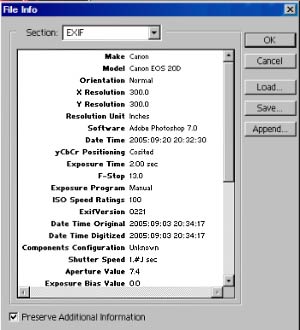
| BUY |
|
| ADVICE | ||||||||||
| more . . .
|
||||||||||
| OTHER SITES |
|
EXIF
Explaining the hidden information stored in your digital photographs
 |
Although not universal, a large number of cameras are exif-enabled and it is well worth checking yours. The data stored can give you valuable information about your photograph and is also useful to some cataloguing software.
Most leading image-editing software will handle the exif data, making it available for you to view, but you should also be aware that it can easily be deleted by non-compliant software or by certain image editing.
Some of the most
useful kept in the exif information is:
• Date and time of the photograph
• The exposure program used by the camera
• The metering mode used
• Any exposure compensation applied
• Compression method, e.g. which jpeg quality
• The white balance setting
• The metering mode in use
Preserving your exif data is another good reason for keeping a secure copy of the original of all your photographs, for instance on CD or DVD. If you lose the data in the future it will always be with the original.
Keeping the original intact is always good practice becuase:
1. Your attempts to improve a picture may go wrong and you might inadvertently
make it worse,
2. No matter how please you might be with your efforts you may learn better
ways to improve it later, or newer software and techniques can offer better
alternatives to what you have done

![]() Click [
here ] to email
Click [
here ] to email